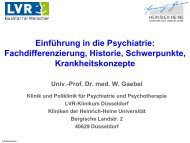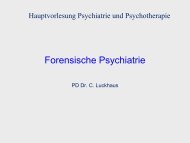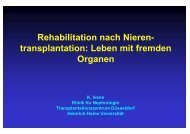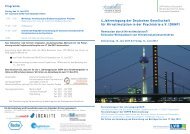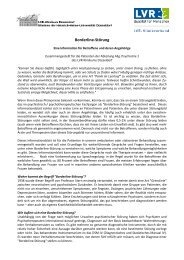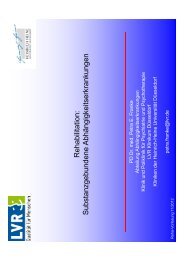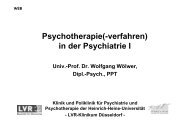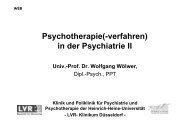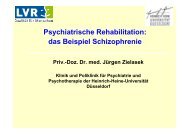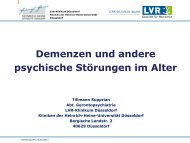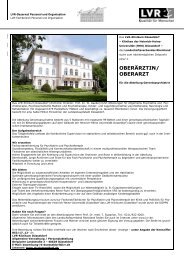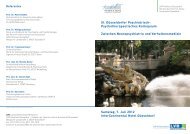LVR-Klinikum Düsseldorf Hospital of the Heinrich-Heine University ...
LVR-Klinikum Düsseldorf Hospital of the Heinrich-Heine University ...
LVR-Klinikum Düsseldorf Hospital of the Heinrich-Heine University ...
You also want an ePaper? Increase the reach of your titles
YUMPU automatically turns print PDFs into web optimized ePapers that Google loves.
<strong>LVR</strong>-KLINIKUM DÜsseLDORF – hOsPITaL OF The heINRIch-heINe UNIVeRsITY DÜsseLDORF<br />
Genetic principles <strong>of</strong> brain perfusion<br />
in Alzheimer’s Dementia<br />
C. Luckhaus, K. Fehsel in cooperation with H. J. Wittsack<br />
(Institute for Radiology <strong>of</strong> <strong>the</strong> <strong>Heinrich</strong>-<strong>Heine</strong> <strong>University</strong>,<br />
<strong>Düsseldorf</strong>) and <strong>the</strong> FMER-funded Competence Network on<br />
Dementia<br />
Project period: from 2007<br />
Financing: Sub-project within <strong>the</strong> FMER-funded Competence<br />
Network on Dementia (Funding No: 01GI0420)<br />
In an ongoing functional neuroimaging study, we were able<br />
to provide evidence for substantial changes <strong>of</strong> regional brain<br />
perfusion already at <strong>the</strong> stage <strong>of</strong> mild cognitive impairment<br />
(MCI), which appeared independently <strong>of</strong> regional atrophy<br />
and <strong>of</strong> <strong>the</strong> APOE epsilon genotype. We are now looking<br />
at <strong>the</strong> question <strong>of</strong> how far regional and global blood flow<br />
values are associated with functional variants <strong>of</strong> relevant<br />
candidate genes (endo<strong>the</strong>lin 1, IL1beta, PP2A activator, NF<br />
kappa B subunit B, KCNN3, NOS 3). Initial findings point to<br />
a specific association <strong>of</strong> two variants <strong>of</strong> <strong>the</strong> NOS3 gene with<br />
global brain perfusion in MCI and Alzheimer’s Dementia.<br />
It is planned to confirm this association and to test o<strong>the</strong>r<br />
associations with o<strong>the</strong>r candidate genes in a larger sample.<br />
Establishing a murine neuronal lesion model in vitro:<br />
investigations into <strong>the</strong> change <strong>of</strong> electrical spontaneous<br />
activity <strong>of</strong> neuronal/glial networks through physical and<br />
neurotoxic lesions<br />
U. Henning, P. Görtz, Ch. Lange-Asschenfeldt and C. Luckhaus<br />
Project period: from 2008<br />
Financing: Departmental research budget<br />
In relation to a possible regeneration <strong>of</strong> <strong>the</strong> central cellular<br />
organisation, investigations were carried out, published in<br />
<strong>the</strong> 1960s, into a paradigm shift proposing that neurons<br />
were able to regenerate constantly in <strong>the</strong> brain. New animal<br />
experiments show that neurogenesis can be stimulated by<br />
activating <strong>the</strong> brain, as well as by drug components. It is<br />
possible to measure <strong>the</strong> functional integrity <strong>of</strong> a neuronalglial<br />
cell association in vitro using multi-electrode array<br />
chip technology (MEA). The functional characteristic <strong>of</strong><br />
this cell model is <strong>the</strong> formation <strong>of</strong> electrical impulses, <strong>the</strong><br />
so-called “bursts”, which can be recorded using a special<br />
recording system. These bursts are quantifiable in relation<br />
to <strong>the</strong> number <strong>of</strong> bursts and <strong>the</strong>ir amplitude. This method<br />
appears to be very suitable for investigating <strong>the</strong> integration<br />
<strong>of</strong> embryonic stem cells (ES) into an electrophysiologically<br />
active cell association. The integration and, <strong>the</strong>reby, <strong>the</strong><br />
differentiation <strong>of</strong> ES, which are experimentally added into<br />
72<br />
<strong>the</strong> network, should influence <strong>the</strong> functional integrity <strong>of</strong> <strong>the</strong><br />
cell association and, <strong>the</strong>reby, <strong>the</strong> MEA-based recording <strong>of</strong><br />
network-evoked potentials (bursts).<br />
Our approach to <strong>the</strong> investigation <strong>of</strong> functional neurogenesis<br />
uses MEA technology to measure <strong>the</strong> activity <strong>of</strong> neuronal<br />
networks before and after <strong>the</strong> induction <strong>of</strong> lesions. The<br />
initial basic experiments will aim to define <strong>the</strong> threshold<br />
concentrations at which cellular damage occurs. A second<br />
phase will test whe<strong>the</strong>r drug components may prevent<br />
damage or result in <strong>the</strong> restoration <strong>of</strong> neuronal activity.<br />
Comorbidity <strong>of</strong> Alzheimer’s Dementia and Osteoporosis<br />
C. Luckhaus, B. Mahabadi, T. Supprian, K. Fehsel in<br />
cooperation with M. Jäger and H. Willenberg<br />
Project period: from 2006<br />
Financing: Departmental research budget<br />
Epidemiological and clinical disease course studies not<br />
only prove a comorbidity link between osteoporosis (Op) and<br />
Alzheimer’s Dementia (AD), but also a link with prodromal<br />
illness stages, such as cognitive decline und decline <strong>of</strong><br />
bone mineral density (BMD). In addition, several molecular<br />
factors, such as oestrogen, NO, ROS and intracellular<br />
signalling pathways, such as GSK-3, are documented as<br />
pathogenetically relevant factors in both illnesses. In this<br />
context, we are investigating biochemical factors <strong>of</strong> bone<br />
metabolism – which are quantifiable in blood plasma –<br />
in patients with Alzheimer’s Dementia, mild cognitive<br />
impairment, osteoporosis and healthy controls. This<br />
should lead to an answer to <strong>the</strong> question whe<strong>the</strong>r common<br />
pathogenetic factors underlie <strong>the</strong>se comorbidities. Initial<br />
findings already indicate significant differences between <strong>the</strong><br />
diagnostic groups, which point to asymptomatic, vitamin<br />
D-independent bone resorption and bone remodelling<br />
processes at <strong>the</strong> MCI stage. Specific markers <strong>of</strong> bone<br />
resorption will now be investigated. A cell-biological<br />
approach will address <strong>the</strong> question <strong>of</strong> whe<strong>the</strong>r <strong>the</strong>se and<br />
additional plasma factors altered in AD have an influence<br />
on <strong>the</strong> proliferation and differentiation <strong>of</strong> CD34-negative<br />
mesenchymal stem cells.



